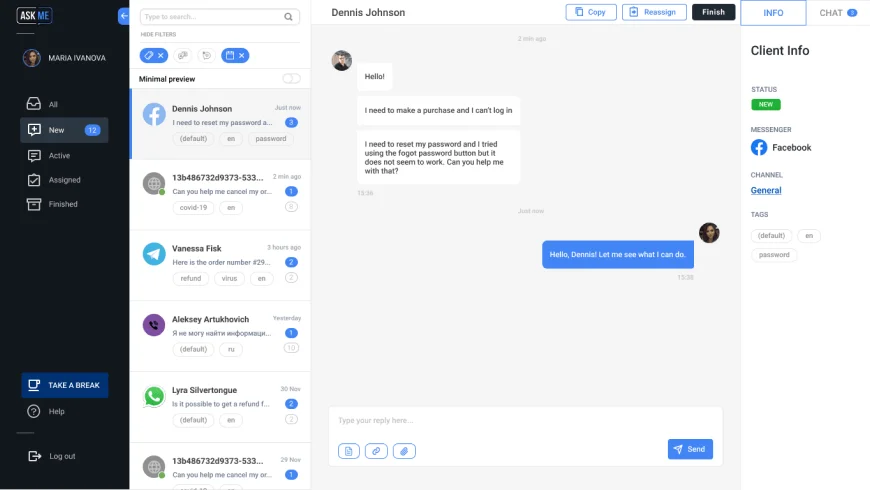There is one area of business that can benefit from AI particularly well—customer support. You might be understandably nervous about how AI could impact your role in customer service. “While AI can provide accurate and fast responses, it often lacks the ability to understand and empathize with customer emotions,” says Director at Cyphere Harman Singh. While AI itself isn’t exactly new, the sheer level of availability of this tech to humans is.
Technologies like chatbots and sentiment analysis can help your support team streamline their workflow, address customer requests more quickly, and proactively anticipate customer needs. Many straightforward operations that an agent used to complete can be automated with robotic process automation (RPA). For example, automating bots to handle record updates, problem management, or proactive customer engagement can significantly lower costs and enhance efficiency and processing times. Asking the customer service representatives is one of the finest ways to find out where RPA can help with customer service. It is one of the best promising examples of artificial intelligence customer service. Robotic process automation (RPA) can automate many simple tasks that an agent used to perform.
Route customers efficiently
All in all, AI customer service is destined to become the standard in the business world. It improves customer support in a multitude of ways, cuts costs, and makes the work of your support agents more efficient. Most importantly, it boosts customer satisfaction what is AI customer service with the power of state-of-the-art technology. “Although our chatbot could provide quick and accurate responses, it may not have been able to deliver the same level of personalized interaction that a human customer service representative could provide.”

Topic clustering and aspect-based sentiment analysis give you granular insights into business or product areas that need improvement, by surfacing common themes in customer complaints and queries. This includes insights on customer demographics and emerging trends—key to guiding your customer care strategy. Machine learning elevates support functions across channels, including social media customer service, effortlessly with intelligent automation.
Using AI-generated content in agent responses
Introduced as “Macy’s on Call,” this smartphone-based assistant can provide personalized answers to customer queries. It can tell you where products or brands are located or what services and facilities are available in each store. AI can even analyze a customer interaction and understand the customer’s sentiment and intent.

Some customer service reps are closing 90% more than the number of conversations they were closing before the AI Assistant. While AI Suggestions are a great advantage for the entire team to quickly resolve basic customer issues and faqs, the AI Assistant is providing a precise, in-depth, and polite response to the support rep. Cause even if you manage to solve 90% of the support requests with fully automated AI, 10% must be analyzed and processed by humans. Now that we have cleaned the content, we needed to use an index to store our customers’ help center articles and canned responses.
AI Customer Service
It can also keep customers updated about new products or services that align with their purchase history. AI simplifies workflows, allowing your team to focus on high-value tasks by introducing streamlined tools and automation. Shortly, the call center will continue to require significant human engagement. AI is thereby supplementing agents’ work rather than replacing it, making it simpler, more effective, and efficient for agents to accomplish their duties. OCR allows you to program your systems to read documents like invoices or orders, extract the pertinent data, and automatically fill in the appropriate fields. By processing documents more digitally and effectively, you may assist in information retrieval from paper documents that are quicker and more precise.
AI can free up human agents to focus on more complex, high-value tasks and improve customer service teams’ overall efficiency and effectiveness. The collaboration between AI and human agents is key to providing the best possible customer experience. It revamped existing channels, improving straight-through processing in self-service options while launching new, dedicated video and social-media channels. To drive a personalized experience, servicing channels are supported by AI-powered decision making, including speech and sentiment analytics to enable automated intent recognition and resolution. The humble chatbot is possibly the most common form of customer service AI, or at least the one the average customer probably encounters most often. When used effectively, chatbots don’t simply replace human support so much as they create a buffer for agents.
Uninterrupted (or fewer interruptions in) service
“This might be unconventional, but we use AI aids to train our agents by getting them to roleplay different customer service scenarios,” says CEO of CabinetSelect Chris Alexakis. But if it’s a complicated query, “the chatbot can transfer the interaction to an executive. Hence, there won’t be a waste of time for the customers.” The State of AI Report cites routing requests to reps as the most popular customer service use case for AI/automation. For context, 29% of experts surveyed mentioned this as their preferred use case.

In the insurance industry, for example, leading companies are now using AI to power every aspect of the policyholder experience and the claims process. Customer Lifetime Value (CLV) is a metric that tracks how valuable a customer is to a company throughout the relationship. CLV is based on the premise that retaining existing customers delivers a higher return on investment than acquiring new ones.
L1 Support
Numerous sectors are integrating AI tools into their production and service delivery processes, taking the opportunity to accelerate, streamline and improve different areas of their operations with this technology. Apart from scraping customer requests and questions to support, AI-powered sentiment analysis tools can also help with social listening. They also monitor brand reputation, catch feedback comments on social media, and gather insights for product improvement. When thinking about AI customer service, chatbots are usually the first thing that comes to mind. And no wonder, since AI chatbots have proved time and time again how powerful they are. And now, chatbots use machine learning and natural language processing to provide exceptional customer service and assist visitors whenever needed.
- There are also things like skills-based routing—which isn’t technically AI—but it can help you make sure your newest agents aren’t the first ones to get those difficult phone calls.
- Since routine tasks can be handled by virtual agents, complicated customer queries can get the timely attention they need from live support agents.
- Getting started with AI for customer service is a transformative step towards supercharging your support workflow and boosting your team’s efficiency.
- With access to the right data and customer context, bots can proactively make personalized recommendations based on a customer’s preferences, website behavior, previous conversations, and more.
- Supporting a global customer base is difficult for companies that don’t have enough multi-lingual personnel.
We’ve all been in a situation where we need to get an issue resolved ASAP – and it’s the worst when you get an automatic message saying that the wait time is over an hour. AirHelp has assisted over 16 million passengers experiencing canceled, overbooked, or delayed flights. As a leader in the traveler claims category, it’s always received a high volume of queries. The system can suggest different menu items based on the person’s estimated age and mood. For example, a 20-year-old male could be offered a meal with a crispy chicken sandwich, roasted chicken wings, and coke. A 50-year-old female might be offered porridge and soybean milk for breakfast.
Process Improvements
Businesses can benefit from artificial intelligence in many ways, from improving consumer experiences to automating repetitive jobs. But creating internal AI-based solutions is a difficult process that costs money. Because of this, companies are enthusiastically adopting AIaaS, a model in which third parties provide ready-to-use AI services. While Interactive Voice Response (IVR) systems have been automating simple routing and transactions for decades, new, conversational IVR systems use AI to handle tasks. Everything from verifying users with voice biometrics to directly telling the IVR system what needs to happen with the help of natural language processing is simplifying the customer experience. Some companies turn to visual IVR systems via mobile applications to streamline organized menus and routine transactions.
AI can also offer to chat on Instagram, Messenger, or WhatsApp for quicker communication if the customer prefers that. However, AI customer service tools know a way to win them over by turning first-time visitors into paying customers who stay loyal to the brand and keep returning. In fact, as many as 57% of businesses are already using AI to improve their customer service. Customer satisfaction is everything when it comes to the ultimate business goals—increasing revenue and growing. Because of its multiple benefits, AI customer service has become the focal point of many companies looking for innovation and growth.
Make proactive recommendations to customers
By creating hyper-personalized content and engagement driven by audience sentiment, they’re reinventing how customers interact with a brand. That’s why sales and marketing teams are teaming up with customer service to understand and overcome barriers to the traditional marketing funnel. James Neave, head of data science at Adzuna, compares soft skills to people skills. He told Insider employers are looking closer at job candidates’ abilities around the squishy stuff. Being strong in areas like communication, leadership, and teamwork can be linked to longevity in a job, greater potential for moving into management, and an ability to build relationships. Employers also see these attributes as indicators people will stay more tied into what they do, he said.
